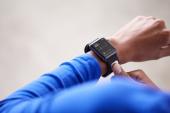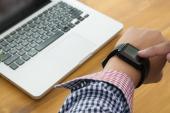Wearable Tech Ups Healthcare Consumption, Ablations for AF
More data are needed to determine the effect on outcomes, but it seems clear that these devices increase overall costs.

Use of wearable technology among patients with known atrial fibrillation (AF) increases consumption of healthcare resources, including ablation, according to new observational data.
With an influx of patients presenting to emergency departments and clinics motivated by warnings on their smart devices, the conundrum for clinicians is what to do with this added information, lead author Libo Wang, MD (University of Utah School of Medicine, Salt Lake City), told TCTMD. At this point, “it's not clear that we have a signal that wearing these devices somehow gets better care. All we're seeing is these folks tend to go to ablation more readily.”
While it’s not unexpected that patients who use smartwatches end up receiving more care, the surprise was that even when controlling for socioeconomic status, something thought of as a “huge effect modifier, we still saw that individuals who used these wearables still went toward ablation a lot more,” he added.
The findings make sense, but even with the adjustment done to the data, it’s likely that substantial selection bias was still present, according to Andrew Foy, MD (Penn State Health, Hershey, PA).
“It's kind of like the ‘worried well’ to some extent,” Foy commented to TCTMD. “People that get [wearable devices] are probably hypervigilant or almost obsessed with monitoring their heart rate and also their atrial fibrillation. So, they are probably more inclined to be going to their electrophysiologist to do things if they see that they are having atrial fibrillation. That being said, it's hard to know whether it was the fact that they had the monitors or that they would just be like this anyway.”
It's not clear that we have a signal that wearing these devices somehow gets better care. Libo Wang
For the study, published online today in JAMA Network Open, Wang and colleagues included 16,320 patients with AF (348 who used wearables) treated at their institution between 2017 and 2019. The most commonly used devices were the Apple Watch, Fitbit (Google), and KardiaMobile (AliveCor), and those who used wearables tended to be younger, healthier, and more affluent.
Researchers looked at two co-primary outcomes: a composite healthcare use score over 90 days as well as mean pulse rate, which served as a surrogate for clinical outcome.
After propensity matching, the researchers compared 125 patients who used wearable devices with 500 who didn’t, and mean pulse rates were similar between the two groups (75.01 vs 75.79 bpm; P = 0.54).
Yet the mean composite healthcare use score, based on actions including ablations, cardioversions, and prescription orders plus professional services but not inpatient hospitalizations, was higher among those using wearables (3.55 vs 3.27; P = 0.04). Ablations in particular occurred more often in those who used wearable tech compared with those who didn’t (17.6% vs 7.4%; P = 0.001).
The results were maintained in regression analyses.
Effect on Outcomes?
While many devices like the Apple Watch may be cleared for use by the US Food and Drug Administration, “they are not actually approved for any specific indication,” Wang said. Barring a prospective, randomized trial, it’s unlikely to know exactly how their use will affect outcomes, although this trial certainly tried, he said.
An explorative finding from this study is that perhaps patients who use wearable tech are more symptomatic than those who don’t, Wang continued. “Is it the chicken or the egg? Is it that individuals who may have more symptoms tend to be the ones using the watches? Or is it the ones that see their watches believe that they have more symptoms?”
These are important questions because “a lot of people that have AF aren't particularly bothered by it when they have episodes,” Foy said. “They're not highly symptomatic and even if they are, they know, especially if they are paroxysmal A-fib, that this is going to go away soon.”
A randomized trial looking at wearable use in this population would take away the selection bias of who might use the technology, Foy observed, but the usefulness of such an endeavor is dubious. “If we already know you have A-fib in the first place, . . . we're not going to be saving lives or even making people feel better if we identify those incidents. So what would the question be of an RCT? Do wearables increase care? I guess that would be a reasonable question, but I don't know why any of the companies would want to sponsor that,” he said, adding that manufacturers are already successfully marketing these devices as consumer products.
As to how clinicians should advise use of wearable tech in AF patients now, Wang said he doesn’t “think it's a clear sell to recommend [these devices] to people with A-fib, which is actually a lot of these patients that are using devices. This is not what the Apple Watch device was actually cleared for. They are not meant for people with preexisting or known arrhythmias.”
Foy said he has not had AF patients come to him with information from wearables. However, “in these other situations where patients that don't have a diagnosis or healthy people using wearables say ‘My device said I have an irregular heartbeat’ or something like that, I always just try to provide reassurance and ask them how they felt,” he explained. “If people were asymptomatic and generally low risk, I usually don't pursue it any further, particularly if in the clinical setting they're not somebody that I would have been worried about before.”
Many physicians might take a similar tack, he added, but “I certainly think there's going to be physicians at the other end of the spectrum that will, as a result of somebody saying that their wearable said that they had an irregular heartbeat, give them a 30-day event monitor or it could certainly lead to a string of medical testing. That's definitely a possibility and does happen.”
This of course would increase healthcare costs across the board. “It's basically impossible that these would be in any way cost-effective under anybody's definition of cost-effectiveness,” Foy said. “At the least, they may pick up an undetected condition here and there, but it would be at the expense of a lot of false worry, a lot of unnecessary tests, and a lot of normal tests.”
Ultimately, “our purpose in the study wasn't to try to say smartwatch bad or smartwatch good,” Wang said. “We really wanted to see how naturally our patients interact with them and what differences in outcomes may occur. It looks like they have more health utilization. It's not to say that's a bad thing, because we can't prove or deny that these could have been meaningful utilizations.”
Down the line, he added that he would like to see more study of wearable tech specifically in AF patients. “I do think that there are probably some benefits here,” Wang concluded. “Another direction we'd like to see is looking at symptoms—standardizing patient-reported symptoms and seeing if this pattern of wearable use as well as their experience in the healthcare system and what their outcomes are, how they tie back to these symptoms. Doing this study made us see how important it is to really keep having more-standard symptom reporting, so we can understand our patients and their behaviors and how they engage with the healthcare system better.”
Yael L. Maxwell is Senior Medical Journalist for TCTMD and Section Editor of TCTMD's Fellows Forum. She served as the inaugural…
Read Full BioSources
Wang L, Nielsen K, Goldberg J, et al. Association of wearable device use with pulse rate and health care use in adults with atrial fibrillation. JAMA Network Open. 2021;4(5):e215821.
Disclosures
- Wang and Foy report no relevant conflicts of interest.






Comments